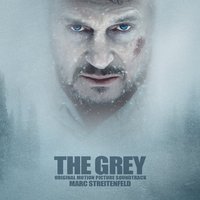
‘You are going to die. That is what’s happening.’
After spending five monotonous weeks working as a hired wolf exterminator ‘doing some of that sniper shit’[i] at an oil refinery in Alaska, near suicidal John Ottoway (Liam Neeson) boards a plane bound for home, along with his fellow men ‘unfit for mankind.’[ii] When their flight clashes violently with a fierce arctic storm, plummeting into the Alaskan wasteland, only eight- including Ottoway- are left alive.
Their struggle for survival begins- and if the gruelling, sub-zero environment wasn’t enough of a challenge- a pack of territorial, indigenous wolves (Canis Lupis) arrive on screen to seal their fate in this icy action thriller. Whilst heading southward, to what they hypothesise is civilisation and protection, they ironically creep gradually closer to wolf territory- where a true dogfight ensues. Pack against pack, they are picked off one at a time by beast or by blistering climate, until only Ottoway remains- in the heart of the wolf den.
In The Grey, chilling action thriller meets plane survival movie staged in the barren Alaska wilderness, director Joe Carnahan challenges you to ‘live and die on this day.’[iii] The Grey’s characteristic tensions are not only defined by the perilous arctic conditions- which annihilate all other life in the movie’s beginning- but by the presence of wolves. Visual effects used in the film magnify the average wolf’s features- such as it’s howl and fur- in order to represent them as monstrous, carnivorous beasts. The wolf pack haunts the film in their onscreen presence and in the audiences anticipation of them and therefore acts as a catalyst for suspense. This establishes the film alongside other canonical works within the thriller lexicon, as plots of thrillers involve characters which come into conflict with abstract or shadowy forces[iv].
The subsequent anxiety of a more imminent death by a spectral ‘force’ propels the only survivors forwards, across perilous ravines and away from the fragile protection of the burning plane wreckage, in a desperate attempt to not only survive, but to flee. Carnahan therefore manipulates his audience’s fears and desires, alongside that of the onscreen characters, to explore the darker sides of human nature. [v]
Moreover, the parallelism of the man pack and the wolf pack invites the audience to question how different human expectations of masculinity are derived from these grotesque versions of wolves. The masculine discourse in The Grey is established early in the film, as Flannery (Joe Anderson) comments that ‘I watched that documentary- about the fag that loved bears.’[vi] The documentary in question, Grizzly Man, follows the life and death of bear activist Timothy Treadwell. The derogatory term ‘fag’relates not only to how Timothy claimed to ‘love his animal friends,’but also the debated subject of his sexuality.[vii] The duality of wolf and human behaviour in the film examines the social establishment of masculinity and sexuality. Therefore, The Grey, in order to expose truths of human behaviour more specific to the thriller genre, and to reveal anxieties surrounding death and masculinity, scribes an aesthetic lie in its depiction of the Canis Lupis.
The manipulation of Canis Lupis within the film is first experienced in its initial encounter with John Ottoway. Whilst he approaches the still moaning human, the wolf peers over the body in a momentary pause from its dinner. In this close up shot (see below), the black mass of the beast emerges as one with the darkness, establishing its phantom presence
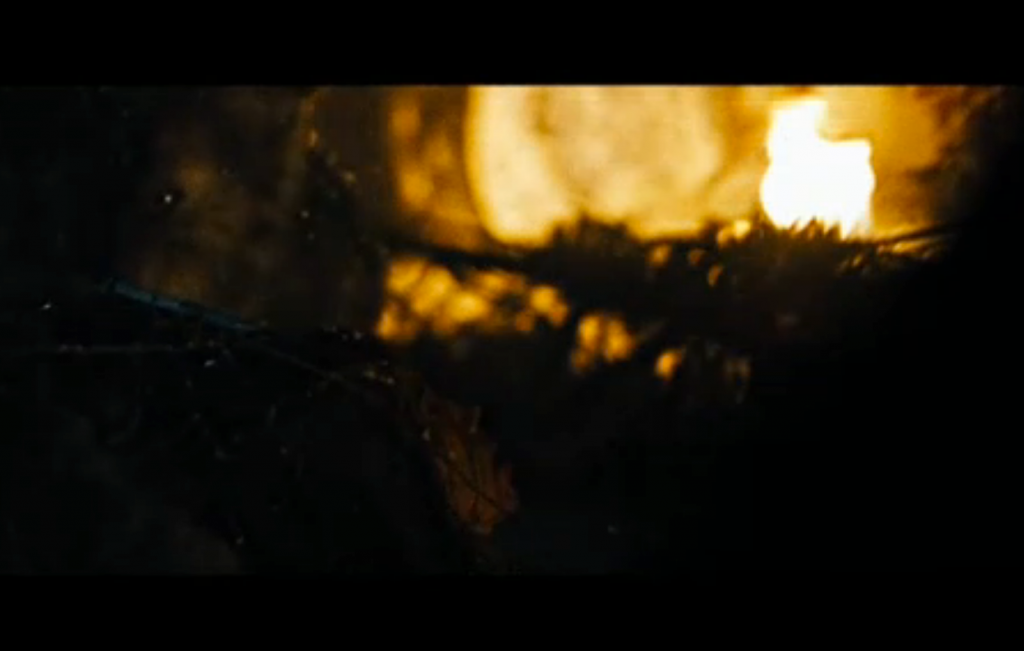
(Screenshot: Wolf eating the human. The Grey, Dir. Joe Carnahan (Inferno, 26 January 2012, USA)
Moreover, as Ottoway turns to aggression, yelling ‘get off her you mother fucker’[i] the wolf’s retaliation which ensues is not clearly seen onscreen. Instead, the audience is met with shaky cam littered with indistinguishable blurred movements and dark shapes.The wolf is depicted as an unfathomable monstrosity lurking in the darkness – an embodiment of terror and death- and emphasises human fear of the unknown. Furthermore, Ottoway’s referral to the wolf as a ‘mother fucker’reiterates the film’s association of fear with a masculine anxiety surrounding sexuality.
Frank Grillo (Diaz) commented that the wolves, ‘have a certain magic to them, they’re bigger, darker, they sound like bull elephants, they don’t sound like real wolves, their growl is much deeper- and that is by design.’[i] Though typically a soundtrack creates tension for the audience, in The Grey, it is the growling of the wolves which generates an uncomfortable sensory reaction. The snarling announces their presence before their physical appearance, and the direction of the camera towards the darkness encapsulates the disembodiment of the wolves. This further separates them from humanity, and transforms the wolves into the supernatural spectre which haunts the characters. The Grey anticipates and exploits the audience’s association of the sounds of a wolf howling with fear and trepidation, as the noise is a cinematic trope used often to announce the arrival or threat of a werewolf.[ii]
Additionally, a purpose built fully animatronic alpha wolf was used in the film. It’s enlarged scale, bloodied jaw and darkened fur are intentionally created to be both physically and aesthetically superior than an average timber wolf. (see below)
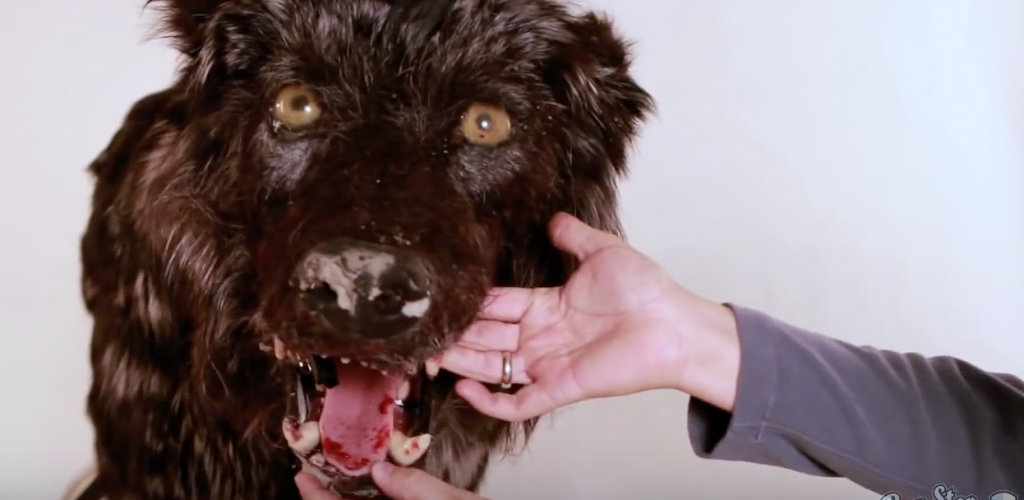
(Mechanical wolf used in The Grey, Youtube, ‘Mechanical Alpha Wolf Puppet’ (2012)<https://www.youtube.com/watch?v=h9zZlKIJ3gU>
This cinematic ornamentation of wolf characteristics combined with CGI and animated robotics are the technical elements which construct the onscreen representation of the Canis Lupis as a monster. Therefore, the film makers- by design- have manipulated the wolf’s aesthetic in order to place them above the humans in this arctic social hierarchy. Additionally, the manipulation strips back potential audience empathy towards the animals, in order to sustain their function as monstrous spectres in the film.
In the man pack’s first encounter with the wolf pack they -and the audience- are propelled into fearful suspense as the wolves’ eyes gradually appear in the darkness. (see below)
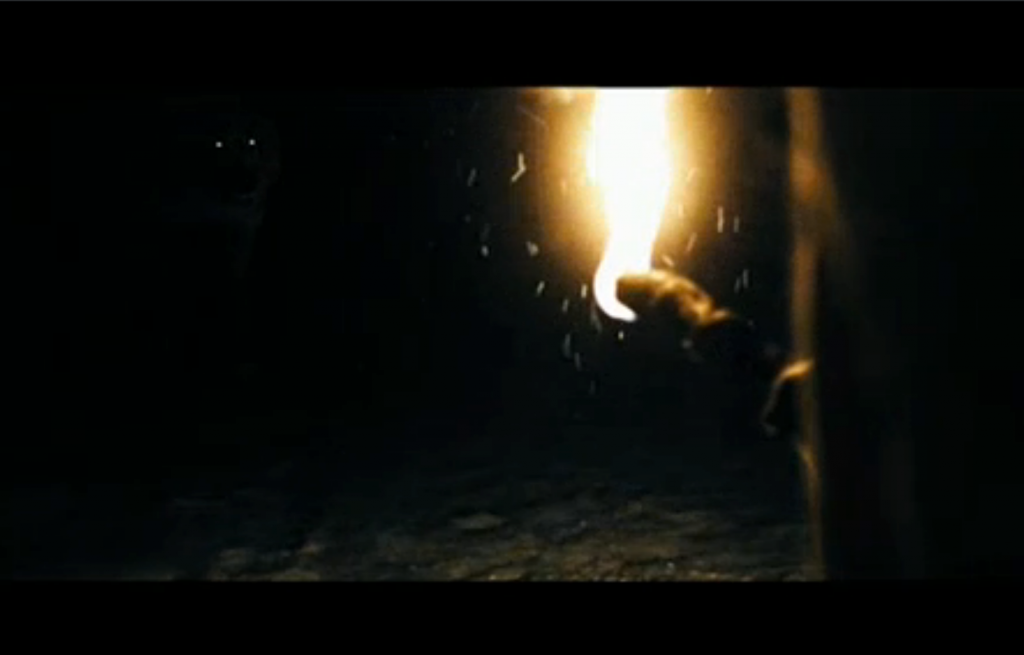
[Screenshots: The darkness and the wolves’ eyes. The Grey, Dir. Joe Carnahan (Inferno, 26 January 2012, USA)]
In the scene, Ottoway creates a standoff between the two groups when he orders the men to ‘stare right back at them.’[i]Liam Neeson commented in an interview, ‘you look into their eyes and its like you’re looking into something scary, powerful, wise, learned and ancient.’[ii] Therefore, in this scene, the film momentarily indulges in the human association with the macho brutality of the wolves as something desirable. The torch’s illumination of the wolves’ eyes is a metaphor for the men seeing their own masculine ideals reflected back upon themselves in the form of a monster. Therefore, the wolves represent everything which the human characters desire- masculine intimidation and power- whilst simultaneously highlighting the human pack’s inferiority and mortality. Consequently, the association of the werewolf with terror implies that the men should not desire only power, as the result is pure monstrosity.
The survival narrative is marginally undercut by a consequent emergence of challenged masculinity. The man pack are struggling between accepting their mortal fate, fighting for their survival, and attempting to establish themselves as a higher masculine being, in the social hierarchy of the Alaskan outback in which the wolves reign superior.In this cinematic world in which only men and wolves have physical presence we witness the struggle to define masculinity and its respective factions of emotional weaknesses such as fear.
Joe Carnahan stated that, ‘the two packs were meant to be this kind of core area, the alpha and the alpha- that’s intentional,’[i] a concept denoted in the initial sketches of the plot. (see below)
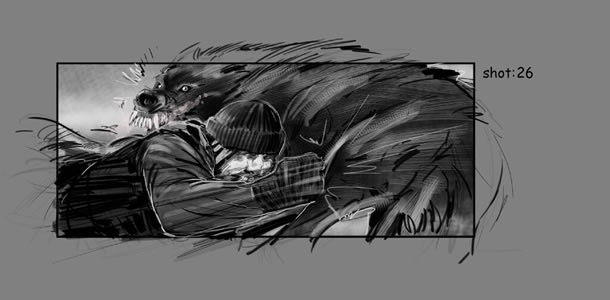
[Storyboard image of the final Alpha battle. Coming Soon ‘Neeson vs. Wolf: Storyboard Depicting unseen final fight in ‘The Grey’ (2013) <http://www.comingsoon.net/movies/news/575026-neeson-vs-wolf-storyboard-depicting-unseen-final-fight-in-the-grey>]
Consequently, Diaz demands the defining of the Alpha, ‘‘who’s in charge of this right now, this guy?’[i]providing parallelism between the man pack and the wolves, in order to reflect on their own expectations of strength and masculinity. The lexical field of fear within the script is a response to this reflection, as Ottoway calls Diaz out, claiming that ‘talking tough means jack shit now, you aint scared? you’re a fool.’[ii]Through this, the male bravado is shunned by Ottoway and instead vulnerability is demanded in the other men. Paradoxically, as the narrative develops and humans are peeled away, the wolves’s aesthetic representation of powerful maleness is reversed. In the face of this threat, the humans are to accept fear -what would originally negate toughness- in order to become a more manly, powerful ‘great white hunter.’[iii]
Moreover, it suggests to the audience that it is acceptable to be afraid whilst watching a thriller, in that part of the process of personal reflection is what causes those fears to manifest. Therefore, the wolves method of establishing dominant order, is utilised in order to express the boundaries of what defines men, or more widely, human (emotional) nature.
Therefore, the wolves are, in response to the survival genre of the film, used specifically for the intention of creating a more extreme scenario; and yet in actual fact, the humans choose to go towards the wolves, retaliate to their attacks, and furthermore force themselves into dangerous chases. These actions are spurred by the characters’masculine fears and rejection of weaknesses and leads to their demise. Subsequently, John Ottoway appears to survive the film in its concluding moments, as he acknowledges his own terror.
The purpose of animals in thriller films – to expose human emotion- is a technique reminiscent of Jaws [iv](1975), a classic of the thriller canon. It also features aesthetic manipulation, this time in sharks, in order to make the animal appear ridiculously oversized and intimidating. There is a consequential comedic aspect to be drawn from this, for example in this ‘alternate universe’ image in which the human and shark switch positions.(see below)

[Alternate universe GIF based on Jaws. Imgue, ‘Jaws in the Parallel Universe’(2015) <http://imgur.com/gallery/6fVXrBX>]
It shows a frivolity of the plot, in that to uncover a true vulnerability in men, you have to expose them to supernatural extremes. Moreover, the audience can question why we fear animals with such resonance, when the fragility in character comes from our own social expectations of what is manly and therefore powerful. Dias’s chilling comment rings true, ‘you’re not the animals, we are.’[i]
[i]The Grey, Dir. Joe Carnahan (Inferno, 26 January 2012, USA)
[i]The Grey, Dir. Joe Carnahan (Inferno, 26 January 2012, USA)
[ii]The Grey, Dir. Joe Carnahan (Inferno, 26 January 2012, USA)
[iii]The Grey, Dir. Joe Carnahan (Inferno, 26 January 2012, USA)
[iv]Jaws, Dir. Steven Speilberg (Universal Pictures, 1975, USA)
[i] YouTube, ‘DP/30: The Grey, co-writer/director Jie Carnahan, actor Liam Neeson’(2012) <https://www.youtube.com/watch?v=DIH8Qn8ym9w >
[i]YouTube, ‘Are wolves really man eaters?’(2011) <https://www.youtube.com/watch?v=I8OW2ehY3z4> [accessed 20 November 2015]
[i]The Grey, Dir. Joe Carnahan (Inferno, 26 January 2012, USA)
[ii]YouTube, ‘Are wolves really man eaters?’(2011) <https://www.youtube.com/watch?v=I8OW2ehY3z4> [accessed 20 November 2015]
[ii]An American Werewolf in London, Dir. John Landis (Universal Pictures, 21 August 1981)
[i]The Grey, Dir. Joe Carnahan (Inferno, 26 January 2012, USA)
[i] The Grey, Dir. Joe Carnahan (Inferno, 26 January 2012, USA)
[ii]The Grey, Dir. Joe Carnahan (Inferno, 26 January 2012, USA)
[iii]The Grey, Dir. Joe Carnahan (Inferno, 26 January 2012, USA)
[iv]Filmstore, ‘Thriller- Suspense films’<http://www.filmsite.org/thrillerfilms.html> [accessed 19 November 2015] (para. 2)
[v]Filmstore, ‘Thriller- Suspense films’<http://www.filmsite.org/thrillerfilms.html> [accessed 19 November 2015] (Para. 10,16)
[vi]The Grey, Dir. Joe Carnahan (Inferno, 26 January 2012, USA)
[vii]Grizzly Man, Dir. Werner Herzog ( Lions Gate Films, 12 August 2005, USA)
Suggestions for further reading:
Other films/thriller genre:
- An American Werewolf in London, Dir. John Landis (Universal Pictures, 21 August 1981)
- The Birds, Dir. Alfred Hitchcock (Universal Pictures, 1963, United States)
- Grizzly Man, Dir. Werner Herzog (Lions Gate Films, 2005, United States)
- Jeffers, Ian, The Grey, (212 Books, 2013)
Websites, Interviews and Critical Readings:
- A.V.Club, ‘The Grey is not really about Liam Neeson battling wolves’<http://www.avclub.com/article/grey-not-really-about-liam-neeson-battling-wolves-212654>
- Daniel-Richard, Debra, ‘The Dance of Suspense: Sound and Silence in North by Northwest,’Journal of Film and Video, Vol. 62, No. 3 (2010) <http://www.jstor.org/stable/10.5406/jfilmvideo.62.3.0053>
- The Guardian, ‘The Grey’s hero, dead? Perish the thought’ <http://www.theguardian.com/film/2012/may/31/greys-ending-liam-neeson>
Bibilography:
- Coming Soon ‘Neeson vs. Wolf: Storyboard Depicting unseen final fight in ‘The Grey’ (2013) <http://www.comingsoon.net/movies/news/575026-neeson-vs-wolf-storyboard-depicting-unseen-final-fight-in-the-grey> [accessed 18 November 2015]
- Filmstore, ‘Thriller- Suspense films’<http://www.filmsite.org/thrillerfilms.html> [accessed 19 November 2015]
- Imgue, ‘Jaws in the Parallel Universe’(2015) <http://imgur.com/gallery/6fVXrBX>
- Jaws, Dir. Steven Speilberg (Universal Pictures, 1975, USA)
- The Grey, Dir. Joe Carnahan (Inferno, 26 January 2012, USA)
- YouTube, ‘Are wolves really man eaters?’(2011) < https://www.youtube.com/watch?v=I8OW2ehY3z4> [accessed 20 November 2015]
- Youtube, ‘Mechanical Alpha Wolf Puppet’ (2012)<https://www.youtube.com/watch?v=h9zZlKIJ3gU> [accessed 20 November 2015]
- YouTube, ‘DP/30: The Grey, co-writer/director Jie Carnahan, actor Liam Neeson’(2012) <https://www.youtube.com/watch?v=DIH8Qn8ym9w> [accessed 20 November 2015]